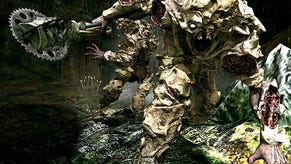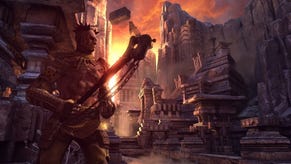Rage
The first two hours.
But in every sense that should matter to an id Software fan, it's fast and furious. When you reach the bandit camp that Dan Hagar sent you to, you go through a door and find yourself in an id Software first-person shooter.
The building you're in is a rundown tenement block overlooking a canyon. Inside, the bandits have piled up rubbish and built wooden gangways, and there are skulls on sticks and graffiti smeared on the walls in blood. At one point I think I spy a Quake symbol among the chicken-scratch.
Within seconds, that id Software feel starts to assert itself. You have to aim your pistol for yourself, which itself is virtually unheard of in modern FPS games, and as you work through rooms and neat arrangements of corridors (blessed corridors!) bandits either fire at you with their own popguns or sprint towards you prancing around waving scythe-like blades in your direction.
After a few of these missions you've built up a nice little arsenal. There's a meaty combat shotgun that stops almost anything in its tracks, a silent crossbow with a handy zoom function, and a supply of wingsticks – bladed throwing weapons that happily decapitate anything they boomerang their way into at head height. Juggling your growing inventory of killing implements through some handy controller shortcuts, you feel pretty badass.
Rage's levels are also packed with shiny objects that the magpie eyes of BioShock veterans will surely appreciate, and once you dig up a few blueprints – themselves found in locked rooms and other dark corners, or bought from traders – all these cogs, springs and bits of metal can be mashed together on the engineering screen to give you more combat items.
There's the lockgrinder, for example, which breaks through specific door seals (usually giving you access to some more loot), and there's a little spider bot who wanders around shooting people for you, while EMP grenades can be used to disable forcefields and automated sentry guns.
There are also alternative ammo types to master. The best of the ones we've used so far is probably a mind-control bolt for the crossbow. Fire it into an enemy in a crowd and you switch to a third-person view of him as he flails around with a bolt sticking out of his head. When you're ready and he's good and close to his friends, you hit the "detonate" button and watch the blood rain.
Rage isn't really gratuitous in a nasty way, incidentally – it's slightly cartoonish, full of mutants and fascistic special forces – but it isn't shy about making mince and giblets out of anyone dumb enough to stand next to an explosion. The first time I take someone's head off with the wingstick at close range I burst out laughing, and once I get my hands on the rocket launcher, it takes a force of will to save it for later and not just fire off every wonderful round.
After years of RPG tubes with two-second reloads, getting your hands on a fast and brutal id Software rocket launcher again is like that moment in Prince of Persia: The Sands of Time when you first shimmied along a ledge without pausing between hand holds. And how nice to simply keep it in the tool bag with countless other weapons and gadgets rather than having to drop something.
The most surprising diversion from formula is actually rather welcome: there's a recharging health system– take a few hits and the screen tints red and you need a moment to recover – but if you're properly knocked down you can still come back using a defibrillation mini-game. On consoles this involves pushing analogue sticks in different directions to build a charge and then hitting the triggers together to jolt yourself back to life – with the added benefit of zapping nearby enemies to death.










.png?width=291&height=164&fit=crop&quality=80&format=jpg&auto=webp)




.jpg?width=291&height=164&fit=crop&quality=80&format=jpg&auto=webp)
